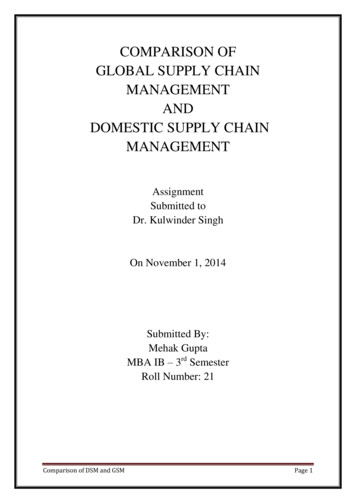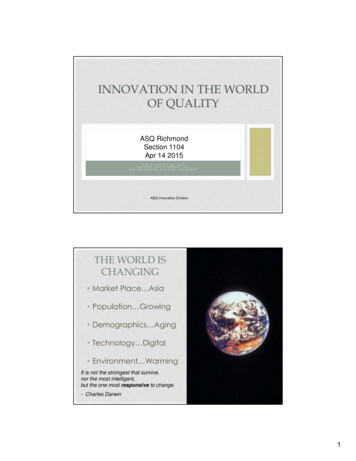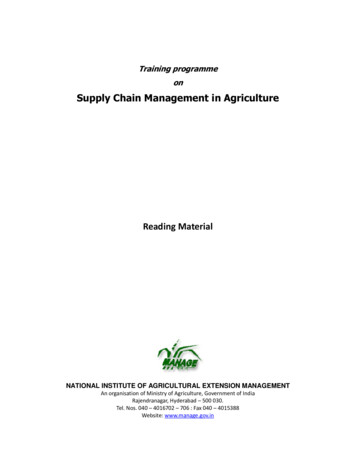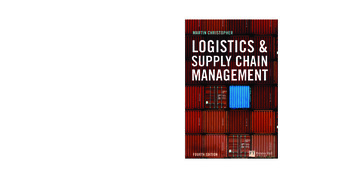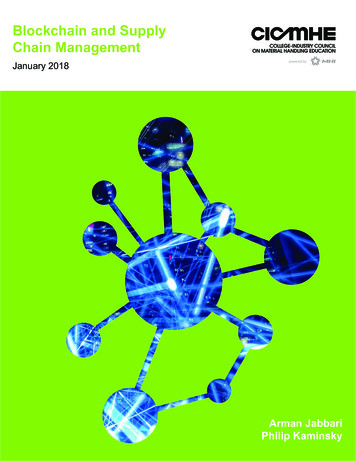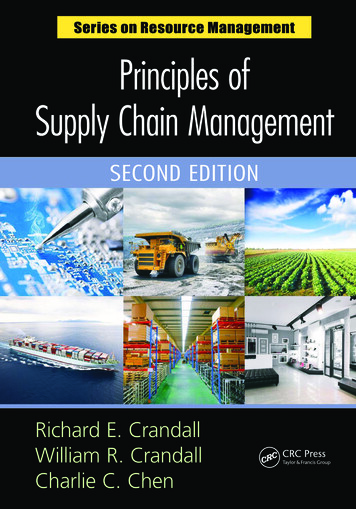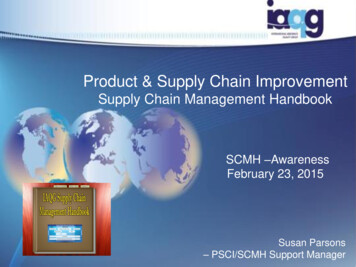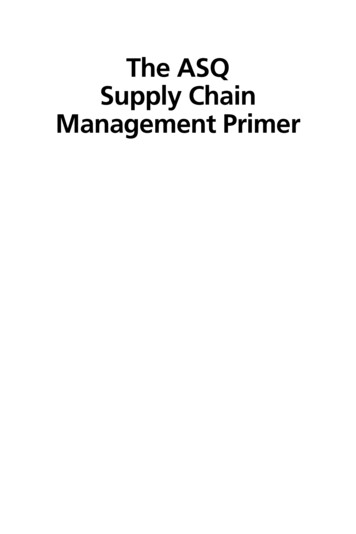
Transcription
The ASQSupply ChainManagement Primer
Also available from ASQ Quality Press:A Practical Application of Supply Chain Management PrinciplesThomas I. SchoenfeldtThe Supplier Management Handbook, Sixth EditionASQ Customer-Supplier Division; James L. Bossert, editorComplex Service Delivery Processes: Strategy to Operations, Second EditionJean HarveyThe Executive Guide to Innovation: Turning Good Ideas into Great ResultsJane Keathley, Peter Merrill, Tracy Owens, Ian Meggarrey, andKevin PoseyThe ASQ Auditing Handbook, Fourth EditionJ.P. Russell, editorPrinciples of Quality Costs: Financial Measures for Strategic Implementationof Quality Management, Fourth EditionDouglas C. Wood, editorPerformance Metrics: The Levers for Process ManagementDuke OkesRoot Cause Analysis: Simplified Tools and Techniques, Second EditionBjørn Andersen and Tom FagerhaugThe Certified Manager of Quality/Organizational Excellence Handbook,Fourth EditionRussell T. Westcott, editorThe Quality Toolbox, Second EditionNancy R. TagueThe ASQ Quality Improvement Pocket Guide: Basic History, Concepts, Tools,and RelationshipsGrace L. Duffy, editorThe Internal Auditing Pocket Guide: Preparing, Performing, Reporting andFollow-up, Second EditionJ.P. RussellTo request a complimentary catalog of ASQ Quality Press publications,call 800-248-1946, or visit our Web site at http://www.asq.org/quality-press.
The ASQSupply ChainManagement PrimerJ.P. Russell, EditorASQ Quality PressMilwaukee, Wisconsin
American Society for Quality, Quality Press, Milwaukee, WI 53203 2014 by ASQAll rights reserved. Published 2013.Printed in the United States of 2 1Library of Congress Cataloging-in-Publication DataThe ASQ supply chain management primer/editor, J.P. Russell.pages cmIncludes bibliographical references.ISBN 978-0-87389-867-6 (hardcover: alk. paper)1. Business logistics. I. Russell, J.P. (James P.), 1945HD38.5.A87 2013658.7—dc232013037474No part of this book may be reproduced in any form or by any means, electronic,mechanical, photocopying, recording, or otherwise, without the prior writtenpermission of the publisher.Acquisitions Editor: Matt T. MeinholzManaging Editor: Paul Daniel O’MaraProduction Administrator: Randall BensonASQ Mission: The American Society for Quality advances individual,organizational, and community excellence worldwide through learning, qualityimprovement, and knowledge exchange.Attention Bookstores, Wholesalers, Schools, and Corporations: ASQ QualityPress books, video, audio, and software are available at quantity discounts withbulk purchases for business, educa tional, or instructional use. For information,please contact ASQ Quality Press at 800-248-1946, or write to ASQ Quality Press,P.O. Box 3005, Milwaukee, WI 53201-3005.To place orders or to request ASQ membership information, call 800-248-1946.Visit our Web site at www.asq.org/quality-press.Printed on acid-free paper
ContentsList of Figures and Tables. . . . . . . . . . . . . . . . . . . . . . . . . . . . . . . . . . . . . .ixForeword. . . . . . . . . . . . . . . . . . . . . . . . . . . . . . . . . . . . . . . . . . . . . . . . . . .xiNotes to the Reader. . . . . . . . . . . . . . . . . . . . . . . . . . . . . . . . . . . . . . . . . . .xiiiAcknowledgements. . . . . . . . . . . . . . . . . . . . . . . . . . . . . . . . . . . . . . . . . . .xvAbout the Authors . . . . . . . . . . . . . . . . . . . . . . . . . . . . . . . . . . . . . . . . . . .xviiChapter 1 Supply Chain Management Briefing . . . . . . . . . . . . . .Define Your Requirements. . . . . . . . . . . . . . . . . . . . . . . . . . . . . . . .Select a Supplier . . . . . . . . . . . . . . . . . . . . . . . . . . . . . . . . . . . . . . . .Award the Business . . . . . . . . . . . . . . . . . . . . . . . . . . . . . . . . . . . . .Build and Strengthen Relationships. . . . . . . . . . . . . . . . . . . . . . . .Monitor the Performance. . . . . . . . . . . . . . . . . . . . . . . . . . . . . . . . .The Enterprise Processes. . . . . . . . . . . . . . . . . . . . . . . . . . . . . . . . .1124567Chapter 2 Define Requirements . . . . . . . . . . . . . . . . . . . . . . . . . . . .General Concepts of Procurement Control. . . . . . . . . . . . . . . . . .Design. . . . . . . . . . . . . . . . . . . . . . . . . . . . . . . . . . . . . . . . . . . . . . . . .Contract/Order Review. . . . . . . . . . . . . . . . . . . . . . . . . . . . . . . . . .991314Chapter 3 Select Suppliers. . . . . . . . . . . . . . . . . . . . . . . . . . . . . . . . .Supply Chain Background . . . . . . . . . . . . . . . . . . . . . . . . . . . . . . .Supply Chain Council and the SCOR Model. . . . . . . . . . . . . . . .Organizational Requirements Planning . . . . . . . . . . . . . . . . . . . .Sourcing. . . . . . . . . . . . . . . . . . . . . . . . . . . . . . . . . . . . . . . . . . . . . . .Strategic Sourcing. . . . . . . . . . . . . . . . . . . . . . . . . . . . . . . . . . . . . . .Sourcing Alternatives. . . . . . . . . . . . . . . . . . . . . . . . . . . . . . . . . . . .Outsourcing. . . . . . . . . . . . . . . . . . . . . . . . . . . . . . . . . . . . . . . . . . . .Sourcing Documents . . . . . . . . . . . . . . . . . . . . . . . . . . . . . . . . . . . .171717181924262728v
viContentsSupplier Selection and Evaluation. . . . . . . . . . . . . . . . . . . . . . . . .Supplier Evaluation Criteria. . . . . . . . . . . . . . . . . . . . . . . . . . . . . .Supplier Evaluation and Selection Survey. . . . . . . . . . . . . . . . . .Approved Supplier List. . . . . . . . . . . . . . . . . . . . . . . . . . . . . . . . . .Supplier Certification. . . . . . . . . . . . . . . . . . . . . . . . . . . . . . . . . . . .2930313232Chapter 4 Award Contracts . . . . . . . . . . . . . . . . . . . . . . . . . . . . . . . .Purchasing Function. . . . . . . . . . . . . . . . . . . . . . . . . . . . . . . . . . . . .Legal Aspects of Purchasing. . . . . . . . . . . . . . . . . . . . . . . . . . . . . .Competition. . . . . . . . . . . . . . . . . . . . . . . . . . . . . . . . . . . . . . . . . . . .Terms and Conditions . . . . . . . . . . . . . . . . . . . . . . . . . . . . . . . . . . .Understanding Costs. . . . . . . . . . . . . . . . . . . . . . . . . . . . . . . . . . . .Specifications and Design Responsibility and Approach. . . . . .Type of Agreements. . . . . . . . . . . . . . . . . . . . . . . . . . . . . . . . . . . . .Team Supplier Selection. . . . . . . . . . . . . . . . . . . . . . . . . . . . . . . . . .Negotiations. . . . . . . . . . . . . . . . . . . . . . . . . . . . . . . . . . . . . . . . . . . .Purchase Order Process. . . . . . . . . . . . . . . . . . . . . . . . . . . . . . . . . .Contract Risk Management. . . . . . . . . . . . . . . . . . . . . . . . . . . . . . .Performance Rules. . . . . . . . . . . . . . . . . . . . . . . . . . . . . . . . . . . . . .35353637373839404040414243Chapter 5 Build Relationships . . . . . . . . . . . . . . . . . . . . . . . . . . . . .Supply Chain Relationships . . . . . . . . . . . . . . . . . . . . . . . . . . . . . .Supplier Relationship Management. . . . . . . . . . . . . . . . . . . . . . . .Customer Relationship Management . . . . . . . . . . . . . . . . . . . . . .Relationships Based on Criticality. . . . . . . . . . . . . . . . . . . . . . . . .Competition and Strategies. . . . . . . . . . . . . . . . . . . . . . . . . . . . . . .Manage Surplus Inventory and Maximize Agility . . . . . . . . . . .Customer–Supplier Value Creation Paradigm. . . . . . . . . . . . . . .Value Propositions . . . . . . . . . . . . . . . . . . . . . . . . . . . . . . . . . . . . . .Supply Chain Maturity Model . . . . . . . . . . . . . . . . . . . . . . . . . . . .Supplier Partnerships. . . . . . . . . . . . . . . . . . . . . . . . . . . . . . . . . . . .Principles of Supplier Partnerships. . . . . . . . . . . . . . . . . . . . . . . .Working Out Partnerships and Collaboration. . . . . . . . . . . . . . .Key Factors in Partnerships. . . . . . . . . . . . . . . . . . . . . . . . . . . . . . .Formal Dispute Resolution. . . . . . . . . . . . . . . . . . . . . . . . . . . . . . .Intellectual Property. . . . . . . . . . . . . . . . . . . . . . . . . . . . . . . . . . . . .Professional Ethics . . . . . . . . . . . . . . . . . . . . . . . . . . . . . . . . . . . . . .4545454747474849505051525354555657
ContentsviiChapter 6 Monitor Supplier Performance . . . . . . . . . . . . . . . . . . .Why Performance Management for Suppliers?. . . . . . . . . . . . . .Verification of Ordered Items. . . . . . . . . . . . . . . . . . . . . . . . . . . . .What Performance Should be Evaluated?. . . . . . . . . . . . . . . . . . .Elements of a Supplier Management Process. . . . . . . . . . . . . . . .Best Practices . . . . . . . . . . . . . . . . . . . . . . . . . . . . . . . . . . . . . . . . . .595960616468Chapter 7 Supply Chain Management Processes . . . . . . . . . . . . .Supply Chain Defined by the Experts. . . . . . . . . . . . . . . . . . . . . .The SCOR Model . . . . . . . . . . . . . . . . . . . . . . . . . . . . . . . . . . . . . . .Plan. . . . . . . . . . . . . . . . . . . . . . . . . . . . . . . . . . . . . . . . . . . . . . . . . . .Sourcing. . . . . . . . . . . . . . . . . . . . . . . . . . . . . . . . . . . . . . . . . . . . . . .Make. . . . . . . . . . . . . . . . . . . . . . . . . . . . . . . . . . . . . . . . . . . . . . . . . .Delivery and Warehousing. . . . . . . . . . . . . . . . . . . . . . . . . . . . . . .Returns. . . . . . . . . . . . . . . . . . . . . . . . . . . . . . . . . . . . . . . . . . . . . . . .Measuring Supply Chain Performance. . . . . . . . . . . . . . . . . . . . .Risk Management. . . . . . . . . . . . . . . . . . . . . . . . . . . . . . . . . . . . . . .69697071727374767779Appendix A: Obsolescence Management . . . . . . . . . . . . . . . . . . . . .83Appendix B: Supplier Assessment Tool. . . . . . . . . . . . . . . . . . . . . . .87Supply Chain Glossary. . . . . . . . . . . . . . . . . . . . . . . . . . . . . . . . . . . . . . . .93Bibliography. . . . . . . . . . . . . . . . . . . . . . . . . . . . . . . . . . . . . . . . . . . . . . . .99Index. . . . . . . . . . . . . . . . . . . . . . . . . . . . . . . . . . . . . . . . . . . . . . . . . . . . . .101
(This page intentionally left blank.)
List of Figures and TablesFigure 1.1Simplified supplier selection process. . . . . . . . . . . . . . . . . . . . . . . . . . .5Table 2.1Product service requirement examples. . . . . . . . . . . . . . . . . . . . . . . . . .11Figure 3.1Purchasing portfolio matrix. . . . . . . . . . . . . . . . . . . . . . . . . . . . . . . . . . . .22Table 3.1Activities in tactical sourcing. . . . . . . . . . . . . . . . . . . . . . . . . . . . . . . . . .23Table 5.1Comparison of traditional versus partnership model. . . . . . . . . . . . . .52Figure 5.1PDCA cycle . . . . . . . . . . . . . . . . . . . . . . . . . . . . . . . . . . . . . . . . . . . . . . . . .54Figure 6.1A continuum of monitoring actions. . . . . . . . . . . . . . . . . . . . . . . . . . . . .63Figure 6.2Flow of supplier management process elements. . . . . . . . . . . . . . . . . .64Table 6.1Supplier quality manual and survey table of contents. . . . . . . . . . . . .65Figure 6.3Example supplier report card. . . . . . . . . . . . . . . . . . . . . . . . . . . . . . . . . .66Figure 7.1SCOR model. . . . . . . . . . . . . . . . . . . . . . . . . . . . . . . . . . . . . . . . . . . . . . . . .71Table 7.1SCOR model performance attributes. . . . . . . . . . . . . . . . . . . . . . . . . . . .77Figure 7.2Risk management process. . . . . . . . . . . . . . . . . . . . . . . . . . . . . . . . . . . . .81ix
(This page intentionally left blank.)
ForewordThe ASQ Supply Chain Management Primer is an investment by theAmerican Society for Quality’s Customer–Supplier Division(CSD) into the quality body of knowledge (QBoK ) and membervalue. Indeed, the inspiration for this text came when we were searchingon how we could best serve our members worldwide. I believed thatplacing this supply chain management fundamentals book in the handsof all our divisional members would permit a developing step in bothour technology and community. I asked Dennis Arter, a key leader inthe development and dissemination of customer–supplier theory andpractice in ASQ’s Customer–Supplier Division, and he agreed. Togetherwe approached J.P. Russell, asking him to gather subject matter expertsand provide the leadership required to bring the book together. In truecommunity fashion, a call went out to the Division’s immense resources.The call was answered and their gifts of wisdom were poured intowritings. JP then performed the skilled work of a master project managerand created a common voice and flow from the individual contributions.Appreciations go out to the contributing authors and CSD leadership.Both made this project possible. Also, thanks to Sue Daniels for hercopyediting and to Quality Press resources, especially Matt Meinholz.I trust you will find The ASQ Supply Chain Management Primerinformative and applicable to your daily work. CSD remains dedicated tothe mission of providing answers that develop, improve, and strengthencustomer–supplier relationships. As a volunteer leader-based community,we welcome members to jump in, be involved, and share their knowledgeof best practices. Our community strength is sourced from each of you.Stephen K. HackerChair of ASQ Global Advisory Committee and ASQ Chair-Elect 2013xi
(This page intentionally left blank.)
Notes to the ReaderThe UseThis primer provides a foundation for supply chain management. Itmay be used by executives to understand the risks and strategic issuessurrounding global sourcing. It is also for purchasing professionalsnew to the idea of supply chain management as an enterprise within anorganization. It can also be used as a review for supply quality specialistsor as an introduction for personnel involved in the supply chainmanagement process.It was written with the assumption of operating in a free andcompetitive environment.The ContentsThe primer is organized by first presenting common processes used topurchase goods and services. Our aim is to cover basic fundamentalresponsibilities and duties for each process. Historically, many of theseactivities operated independent of one another. But as the number ofsuppliers has increased and their geographic locations have expandedglobally, added inefficiencies and risks surfaced.The last chapter of the book brings together the individual methodsplus other tasks necessary to manage a global supply chain. Because ofour approach there is some necessary redundancy, but the degree of detailvaries according to the focus of the chapter. For example, we introducethe SCOR model in a couple of early chapters but it is not discussed indetail until Chapter 7.Obsolescence management is included in the appendix because itgoes beyond basic or fundamental supply chain management.xiii
xivNotes to the ReaderThe GlossaryOriginally we did not plan to include a glossary, but as the supplymanagement field evolved so has the vocabulary and new words andphrases have been introduced to better describe certain actions ortasks. If no appropriate definition existed, the authors created one. Thedefinitions were reviewed, edited, and added to the glossary to help inthe understanding of supply chain management. The first instance of aglossary word is italicized within the main text.
AcknowledgementsAuthorsDennis Arter (primary author Chapter 1)Zubair A. Khurshid (primary author Chapters 3 and 5)Helen Kiesel (general topic author and contributor)Jodi L. Medley-McMahon, (primary author Chapter 6)Akio Miura (primary author Chapter 2)Paul Myerson (primary author Chapter 7)Dan Reid (primary author Chapter 4)Once the ASQ Customer–Supplier Division leaders approved the project,a call went out for contributors. The above persons volunteered theirtime and expertise to join ASQ and the Customer–Supplier Division in aneffort to provide a supply chain primer to fill a growing worldwide need.These experts and practitioners provided the fundamental knowledgeneeded to craft this book. We are thankful and appreciative of theircontributions, patience, and responsiveness to queries. The primer isdesigned to be a starter document for developing fundamentally soundsupply chain networks.ReviewersBeatriz Fuentes Castañeda, Qualified ISO/TS internal auditorand MMOG internal auditorMark Durivage, ASQ Fellow, CMQ/OE, CRE, CQE, CQADick Gould, ASQ Fellowxv
xviAcknowledgementsElias Monreal, ASQ-CQIA, CQPA, CMI, CQT, CSSGB, CCT,CQA, CQE, CMQ/OETeresa A. Whitacre, CQA, CQE, CQM/OE, CSSGB, ASQ FellowThe final development steps of the project involved a peer reviewto make sure the information in the primer is credible and to identifytechnical issues. We thank the above reviewers for taking their valuabletime to review and comment on the draft manuscript. The reviewerspointed out a need to reorganize the primer to better align with projectobjectives.
About the AuthorsDennis Arter is an author, consultant, and trainer from Kennewick,Washington State, United States. He earned a bachelor’s degreein chemistry from the University of Illinois and became a nuclearsubmarine officer. After military service, Arter wrote Quality Audits forImproved Performance, a best seller published by ASQ Quality Press. Heteaches and publishes on auditing, management systems, and risk. Arteris an ASQ fellow, certified quality auditor, and former member of the ASQBoard of Directors.Zubair A. Khurshid, PE, is a management and quality consultant,adjunct faculty member, and guest speaker to executive programs.He holds a bachelor’s degree in electrical engineering and a master’sdegree in engineering management. He is a senior member of ASQ andis certified by ASQ as a Six Sigma Black Belt and manager of quality/organizational excellence. He is also a member of IEEE, APICS, andthe Project Management Institute. Professionally he has contributed invarious management positions to partner and vendor strategy, ISO 9001,Six Sigma, program management, corporate governance, and processesspanning capital and operating budgeting, tender and contracts, invoicingand payments, material management, and service provisioning in theMiddle East and Pakistan.Helen Kiesel is an ASQ senior member, certified quality auditor,RABQSA AS9100 AIEA auditor, and RABQSA quality managementsystem lead auditor. She is a quality systems manager for GoodrichCorporation, with 24 years of aerospace quality experience. Kiesel hasdeveloped, implemented, and maintained quality management systemsthat are certified to ISO 9001 and AS9100 since 1995. She is responsiblefor supplier quality and audits and for facilitating suppliers’ efforts inachieving ISO 9001 or AS9100 certifications. Kiesel was the first recipientof the Quality Systems Update magazine’s Management Representative ofthe Year Award.xvii
xviii About the AuthorsJodi Medley-McMahon is the quality and productivity managerfor the Management Association–MRA’s Institute of Management and acertified principal auditor through RAB-QSA International. McMahon has25 years of managerial and engineering experience with multi-nationalenterprises in several industries, including electronics, plastics coatings,flexible packaging, and software development. She is a consultant andinstructor for MRA, a senior member of ASQ, and a member of the ProjectManagement Institute. She holds undergraduate degrees in biology andchemistry and a master’s degree in engineering management.Akio Miura is an ASQ fellow, certified quality auditor, certifiedquality engineer, certified manager of quality/organizational excellence,certified reliability engineer, certified Six Sigma Black Belt, certifiedbiomedical auditor, certified HACCP auditor, and certified softwarequality engineer He has been a quality management consultant since the1980s and has helped more than 100 companies in Japan and some inthe United States establish management systems and attain certificationto the ISO 9000 series, cGMP, API Spec Q1, MIL-Q 9858A, QS-9000,and other major standards in the 1990s. Miura has been an RAB/IQAapproved lead auditor training course instructor since 1993 and an activecontributor to ASQ discussion forums since 2004.Paul Myerson has more than 30 years of experience in supply chainstrategies, systems, and operations. Myerson holds a bachelor’s degreein logistics from Pennsylvania State University and an MBA in physicaldistribution from Temple University. He has an extensive backgroundas a supply chain professional, consultant, teacher (currently an adjunctprofessor at New Jersey City and Kean Universities), and author. Myersonis the author of Lean Supply Chain and Logistics Management (McGraw-Hill,2012) and currently writes a column for Inbound Logistics magazine and ablog for IndustryWeek magazine on the topic of lean supply chains.Dan Reid, an ASQ fellow and certified quality engineer, is best knownas an author of QS-9000, ISO/TS 16949, ISO 9001, and ISO IWA-1. Whileat the Automotive Industry Action Group, he led successful projects foreffective problem solving, cost of poor quality, and supplier management.Previously at General Motors Corporation, among other assignments heled or supervised more than 40 lean workshops, was the first leader of theInternational Automotive Task Force, and established a supplier qualityfunction at the GM Service Parts Division.
1Supply ChainManagement BriefingSupply chain management is a system. Like all systems, it iscomposed of many connected processes, all working in harmonyto achieve organizational objectives. There are five basic activitieswe must implement for superior achievement of those objectives. Theprocesses in typical sequential order are: Define your requirements. Select a supplier. Award the business. Build and strengthen relationships. Monitor the performance.These five activities apply to all organizations, be they government,industry, healthcare, or education. They form the basis of this primer.Define your requirementsThree things must be defined before you can obtain the goods and servicesyou want:1. Technical requirements. These involve classic form, fit, and function.For manufactured and process items, requirements are usuallycommunicated by a combination of drawings, specifications, andstandards. In the service sector, requirements are often specifiedin a statement of work.2. Accept–reject criteria. Often, we need certain tolerances inmachining or certain percentages in a blend. The work mustbe performed within a certain period of time. These criteria aremeasured and communicated through certificates, reports, andinspections.1
2Chapter One3. Management system requirements. For those few suppliers critical toproduct or service, we need to specify the management system(s)to be used when performing the work. Management systems cancome from government regulations (such as FDA manufacturingpractices), international standards (such as ISO 9001 and spinoffs), national standards (such as ASME’s boiler code), or industrystandards (such as the Joint Commission’s for hospitals and theAmerican Petroleum Institute’s for pipelines). Smaller supplierscan pick and choose from portions of bigger documents, asappropriate. These standard or custom system requirementsbecome the foundation for suppliers’ site-specific manuals,procedures, and assembly sheets.Of course, all these requirements (technical, accept, and management)must be spelled out in a contract or purchase order (PO). To keepcontract instruments reasonably small, we often call out these commondocuments by reference or attachment. Many government andbusiness organizations use standard supplier terms and conditions.They use addenda for customizing (adding or subtracting individualrequirements). To conserve time, energy, and resources, we often placethese common requirements on a server accessible by suppliers andpotential suppliers. The common PDF format is normally used for theseelectronic files.Select a supplierOver time, providers of goods and services build up a reputation.This reputation may be for price, durability, variety, or any number ofdifferent attractors for that supplier’s chosen market: Customers learn about this reputation through experience, in thatthey see their components in other assemblies they have worked on. They learn about this reputation through professional engineeringsocieties, such as quality or mechanical or plastics. They learn about this reputation through their marketing, in printand in television and in electronic media. They learn about this reputation through recommendations froma trusted friend or professional colleague, or from customerfeedback ratings. They learn about this reputation through a sales agent or adistributor.All of this input allows customers to develop a list of possible suppliers.This may be called a bidders list.
Supply Chain Management Briefing3Next customers need pre-award data for making their selection fromthe list of possible suppliers. A common way to obtain these data is to sendout a request for bid to four to six possible suppliers. This is called theshort list. The functional specifications (without proprietary information)are sent, along with quantity and delivery date estimates. If the supplierswish to perform the work, they send a bid back to the customer. Manytypes and pieces of information are included, so the customer can makean informed decision: These data can take the form of catalog descriptions. Supplierswill often produce attractive print catalogs. They make thesecatalogs available to potential customers at trade shows. Theygive the catalogs to sales agents and distributors. Many suppliersnow put catalog information online on their company websites.Often these catalogs can be downloaded as PDF files for sharingand study by the engineers. It is very unusual to see anyproprietary information in catalogs, but general specifications,photos, dimensions, and capabilities are commonly shown. Pre-award data can come from people-to-people conversations.Suppliers often have sales staff members on duty around theclock to answer technical and pricing questions from existing andpotential customers. Some suppliers hire outside sales agents,who are assigned to cover a geographical territory. They call onexisting and potential customers to provide answers. Sales agentsusually receive pay based on the number of calls they make andthe sales they generate. This is called a commission. Pre-award data can come from answers to written surveys (calledquestionnaires) sent by the customer to the possible sources.Today, many of these questionnaires are sent by e-mail or placedon the customer website for potential suppliers to completeonline. A survey that was useful 10 years ago may no longer bevaluable today. Past performance history can be used to make a supplier selection.If the item worked without problems before, it is likely to workagain in the same environment. Sometimes the customer’s customer has provided a list ofpre-approved sources to use. This promotes efficiency in that thedecision work has already been done. It also promotes consistencyin that these pre-approved suppliers are known performers.The practice of pre-approving sub-suppliers is common in theautomotive and aerospace industries.
4Chapter One For really important items or services (high cost, criticalto production or performance, or having risk of failure),customers may need additional data. Some customers may asktheir suppliers to be certified through conformity assessmentregistration programs. ISO 9001 is the most common certificate forquality. For high-value purchases, when quality and reliability arevery important, the customer may send a small team of experts tothe potential supplier’s factory. This team will conduct an on-site,pre-award survey of the top two or three possible sources beforemaking a final decision. Some industries (automotive especially)will use first-article inspection methods. A small quantity ofitems are purchased and then subjected to intense testing at thecustomer site. If those tests are favorable, then large quantities willbe ordered. For services, an organization may try the service for atrial period or for a small project.Once the data are analyzed, the acceptable supplier is placed on anapproved supplier list. This allows the supplier to be used again forfuture work without the need for deep analysis.Award the businessThe buyer (sometimes called purchasing agent or contracting officer)makes a purchasing decision, often in consultation with engineering,quality, safety, environmental, and risk professionals. If a bid was notobtained earlier, it is requested now. In contract language, this is calledthe offer. The supplier is offering goods or services to the customer for aspecific price and with specific terms. In the United States, this practiceis part of the Uniform Commercial Code, commonly called contract law.It is similar to the United Nations Convention on Contracts for the Sale ofGoods, which has been ratified by most nations of the world.Once an offer is received, it is accepted by issuing a purchase order.The purchase order is signed by the buyer, on behalf of the officers ofthe customer. This then becomes an offe
Attention Bookstores, Wholesalers, Schools, and Corporations: ASQ Quality Press books, video, audio, and software are available at quantity discounts with bulk purchases for business, educational, or instructional use. For information, please contact ASQ Quality Press at 800-248-1946, or writ


